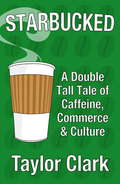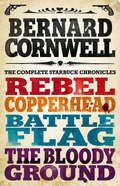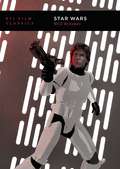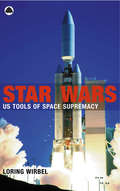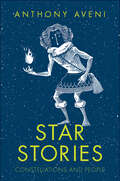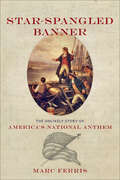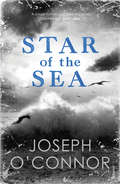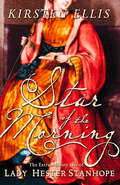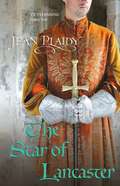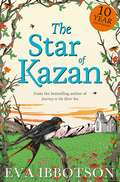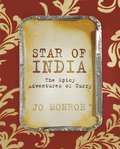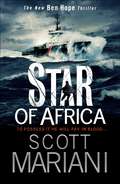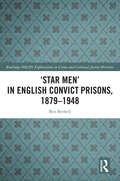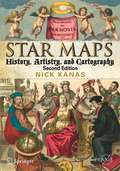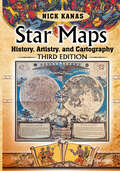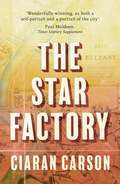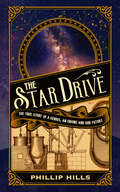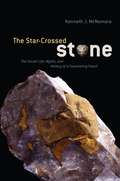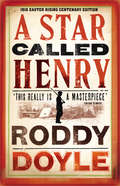- Table View
- List View
Starbucks (Corporations That Changed the World)
by Marie A. BussingFollow the history of Starbucks on its journey from one local retail store in Seattle to a global chain of coffeehouses found in more than 47 countries around the world.Starbucks tells the story of how a single retail outlet opened in 1971 became the world's largest chain of coffeehouses, and for that matter, one of the largest franchises of any kind, with over $10 billion in sales in 2008. Starbucks offers readers the opportunity to get to know this extraordinary corporation's leaders, employees, guiding principles, corporate innovations, competitive strategies, setbacks, and future prospects. Along the way, it explores a number of fascinating issues, including the company's pivotal decision to use Arabica beans instead of mass-produced coffee and its efforts to support sustainable coffee farming worldwide. The book also looks at how Starbucks is coping with the global economic downturn, detailing its recent initiatives to reduce costs, offer healthier food, and re-embrace its coffee-centered, customer-based roots.
Starbucked: A Double Tall Tale Of Caffeine, Commerce, And Culture
by Taylor ClarkSTARBUCKED is the first book to explore the incredible rise of the Starbucks Corporation and the caffeine-crazy culture that fuelled its success. Part Fast Food Nation, part social history, STARBUCKED combines investigative heft with witty cultural observation. How did Starbucks become an international juggernaut? What made the company so beloved that more than 40 million customers visit every week, yet so loathed that protestors have firebombed its stores? Why did Americans suddenly become willing to pay $4.50 for a cup of coffee? And why did the world follow? Taylor Clark provides an objective, meticulously reported look at how Starbucks manipulates psyches and social habits to snare loyal customers, and why many of the things we think we know about the coffee chain are false.
The Starbuck Chronicles: The Complete 4-book Collection
by Bernard CornwellBernard Cornwell’s bestselling series The Starbuck Chronicles, on the American Civil War, now in one complete eBook for the first time.
Star Wars: Creativity, Community And Star Wars Fans (BFI Film Classics)
by Will BrookerThe release of Star Wars in 1977 marked the start of what would become a colossal global franchise. Star Wars remains the second highest-grossing film in the United States, and George Lucas's six-part narrative has grown into something more: a culture that goes far beyond the films themselves, with tie-in toys, novels, comics, games and DVDs as well as an enthusiastic fan community which creates its own Star Wars fictions. Critical studies of Star Wars have treated it as a cultural phenomenon, or in terms of its special effects, fans and merchandising, or as a film that marked the end of New Hollywood's innovation and the birth of the blockbuster. Will Brooker's illuminating study of the film takes issue with many of these commonly-held ideas about Star Wars. He provides a close analysis of Star Wars as a film, carefully examining its shots, editing, sound design, cinematography and performances. Placing the film in the context of George Lucas's previous work, from his student shorts to his 1970s features, and the diverse influences that shaped his approach, from John Ford to Jean-Luc Godard, Brooker argues that Star Wars is not, as Lucas himself has claimed, a departure from his earlier cinema, but a continuation of his experiments with sound and image. He reveals Lucas's contradictory desires for total order and control, embodied by the Empire, and for the raw energy and creative improvisation of the Rebels. What seemed a simple fairy-tale becomes far more complex when we realise that the director is rooting for both sides; and this tension unsettles the saga as a whole, blurring the boundaries between Empire and Republic, dark side and light side, father and son.In his foreword to this new edition, Will Brooker discusses is how subsequent films in the series, specifically Rogue One (2016) and The Last Jedi (2017), foregrounded and developed the themes of opposition that are at the heart of Star Wars. He shows how Derridean theories of opposites which become undermined and subverted, and which change places are made more clear with hindsight and provide us with a useful lens for looking back at the 1977 Star Wars.
Star Wars (BFI Film Classics)
by Will BrookerThe release of Star Wars in 1977 marked the start of what would become a colossal global franchise. Star Wars remains the second highest-grossing film in the United States, and George Lucas's six-part narrative has grown into something more: a culture that goes far beyond the films themselves, with tie-in toys, novels, comics, games and DVDs as well as an enthusiastic fan community which creates its own Star Wars fictions. Critical studies of Star Wars have treated it as a cultural phenomenon, or in terms of its special effects, fans and merchandising, or as a film that marked the end of New Hollywood's innovation and the birth of the blockbuster. Will Brooker's illuminating study of the film takes issue with many of these commonly-held ideas about Star Wars. He provides a close analysis of Star Wars as a film, carefully examining its shots, editing, sound design, cinematography and performances. Placing the film in the context of George Lucas's previous work, from his student shorts to his 1970s features, and the diverse influences that shaped his approach, from John Ford to Jean-Luc Godard, Brooker argues that Star Wars is not, as Lucas himself has claimed, a departure from his earlier cinema, but a continuation of his experiments with sound and image. He reveals Lucas's contradictory desires for total order and control, embodied by the Empire, and for the raw energy and creative improvisation of the Rebels. What seemed a simple fairy-tale becomes far more complex when we realise that the director is rooting for both sides; and this tension unsettles the saga as a whole, blurring the boundaries between Empire and Republic, dark side and light side, father and son.In his foreword to this new edition, Will Brooker discusses is how subsequent films in the series, specifically Rogue One (2016) and The Last Jedi (2017), foregrounded and developed the themes of opposition that are at the heart of Star Wars. He shows how Derridean theories of opposites which become undermined and subverted, and which change places are made more clear with hindsight and provide us with a useful lens for looking back at the 1977 Star Wars.
Star Wars: US Tools of Space Supremacy
by Loring WirbelThe expansion of space militarization forms a common thread with the explicit unilateral empire-building of the Bush administration. But just as Star Wars did not begin with the Missile Defense Agency, preventive war theory did not originate with Donald Rumsfeld. *BR**BR*Advocates of military space always were on the front line of those demanding global dominance. Loring Wirbel argues that the seeds for the current space supremacy doctrine were sown at the end of the Cold War, in the early days of the Clinton administration. Examining the evolution of space-based tools, Wirbel shows that missile defense strategy is part of a dangerous US move to wage endless preventive war and demand global supremacy over allies and adversaries alike.*BR**BR*Star Wars: US Tools of Space Supremacy provides a fresh look at the role of space as an enabler of the Bush administration’s plans for endless preventive war. It debunks the benign notions of missile defence, and expands the definition of space supremacy to include the unilateral misuse of space-based intelligence, communications, and targeting technologies.
Star Stories: Constellations and People
by Anthony AveniFollow an epic animal race, a quest for a disembodied hand, and an emu egg hunt in constellation stories from diverse cultures We can see love, betrayal, and friendship in the heavens, if we know where to look. A world expert on cultural understandings of cosmology, Anthony Aveni provides an unconventional atlas of the night sky, introducing readers to tales beloved for generations. The constellations included are not only your typical Greek and Roman myths, but star patterns conceived by a host of cultures, non†‘Western and indigenous, ancient and contemporary. The sky has long served as a template for telling stories about the meaning of life. People have looked for likenesses between the domains of heaven and earth to help marry the unfamiliar above to the quotidian below. Perfect reading for all sky watchers and storytellers, this book is an essential complement to Western mythologies, showing how the confluence of the natural world and culture of heavenly observers can produce a variety of tales about the shapes in the sky.
Star-Spangled Banner: The Unlikely Story of America's National Anthem
by Marc FerrisNearly every American knows The Star-Spangled Banner, the national anthem of the United States of America. Yet many people dislike the song, contend that it glorifies militarism, and question its suitability as the musical embodiment of nationhood. Even professional vocalists have trouble singing the multi-octave melody and remembering the words. So why in 1931 did Congress designate it as the official national anthem, more than a century after Francis Scott Key put pen to paper?Filled with fascinating, little-known facts drawn from a variety of primary sources, Star-Spangled Banner provides the first narrative history of this controversial song, which turns 200 years old in 2014. Marc Ferris’s lively account, which traces the evolution of the song’s instant popularity as well as its use and abuse by Americans of different political stripes, also explains the changing rituals surrounding the song, including the practice of standing—with hats removed and hand held over the heart—during public performances.This entertaining book will appeal to patriots of all persuasions, along with sports fans, musicians, veterans, history buffs, and anyone who has ever struggled to hit the high notes in the land of the free and the home of the brave.
Star-Spangled Banner: The Unlikely Story of America's National Anthem
by Marc FerrisNearly every American knows The Star-Spangled Banner, the national anthem of the United States of America. Yet many people dislike the song, contend that it glorifies militarism, and question its suitability as the musical embodiment of nationhood. Even professional vocalists have trouble singing the multi-octave melody and remembering the words. So why in 1931 did Congress designate it as the official national anthem, more than a century after Francis Scott Key put pen to paper?Filled with fascinating, little-known facts drawn from a variety of primary sources, Star-Spangled Banner provides the first narrative history of this controversial song, which turns 200 years old in 2014. Marc Ferris’s lively account, which traces the evolution of the song’s instant popularity as well as its use and abuse by Americans of different political stripes, also explains the changing rituals surrounding the song, including the practice of standingâ€�with hats removed and hand held over the heartâ€�during public performances.This entertaining book will appeal to patriots of all persuasions, along with sports fans, musicians, veterans, history buffs, and anyone who has ever struggled to hit the high notes in the land of the free and the home of the brave.
The Star Of The Sea
by Joseph O'ConnorIn the bitter winter of 1847, The Star of the Sea sets sail from Ireland for New York. Amongst the passengers are a maidservant with a devastating secret, bankrupt Lord Merridith and his family, an aspiring novelist and a maker of revolutionary ballads. All in search of a new home in the Promised land, each is yet connected more deeply than they can possibly know... and a camouflaged killer is stalking the decks, hungry for vengeance and absolution.
Star of the Morning (Text Only): The Extraordinary Life Of Lady Hester Stanhope (text Only)
by Kirsten EllisThe dramatic story of Lady Hester Stanhope – a wilful beauty turned bohemian adventurer – who left England as a young woman, unashamedly enjoyed a string of lovers and established her own exotic fiefdom in the Lebanese mountains where she died in 1839.
The Star of Lancaster: (Plantagenet Saga) (Plantagenet Saga #11)
by Jean PlaidyContinuing Jean Plaidy's popular Plantagenet series, here is the dramatic story of King Henry the Fifth's rise from wayward youngster to warrior king. Richard the Second is losing his hold on the crown and Henry of Bolingbroke, previously exiled by the king, returns to England to claim it. Richard is deposed and dies mysteriously, murdered some say on the orders of Bolingbroke, now King Henry the Fourth. But Henry finds the crown harder to hold onto than it was to win. He is beset by enemies, hampered by disease, and concerned about the rebellious behaviour of his son. Dominating the court and with his eye on the crown is Harry of Monmouth, whose reckless conduct in low-class taverns with his crony Sir John Oldcastle causes scandal. When the king dies, Harry became King Henry the Fifth, and the change is dramatic for both him and Oldcastle. The licentious youth becomes a great king, and Oldcastle, the rake, turns into a religious reformer. Oldcastle dies a martyr and Harry becomes the conquering hero of Agincourt. The Star of Lancaster is in the ascendant. Harry has brought France to her knees and married her princess. It seems that the long war was at an end. But a greater enemy than the French awaits Harry ...
The Star of Kazan
by Eva IbbotsonIn 1896, in a pilgrim church in the Alps, an abandoned baby girl is found by a cook and a housemaid. They take her home, and Annika grows up in the servants' quarters of a house belonging to three eccentric Viennese professors. She is happy there, but dreams of the day when her real mother will come to find her. And sure enough, one day a glamorous stranger arrives at the door. After years of guilt and searching, Annika's mother has come to claim her daughter, who is in fact a Prussian aristocrat whose true home is a great castle. But at crumbling, spooky Spittal Annika discovers that all is not as it seems in the lives of her new-found family . . .Eva Ibbotson's hugely entertaining The Star of Kazan is a timeless classic for readers young and old.
Star of India: The Spicy Adventures of Curry
by Jo MonroeHow did the curry get here and how did the Brits, a nation famed for a love of bland food, end up with Chicken Tikka Masala as their favourite dish? It is a history that took curry, via the British Empire, from its Eastern origins, around the globe. This book talks to the men and women who gambled everything to make a living, who endured indifference and racism to secure an income and those who got their relatives to pack the cardamom when they visited as there was no other way of obtaining the ingredients. This book looks at how the British love affair with curry has changed lives, not just in Britain but around the globe
Star of Africa: Star Of Africa, The Devil's Kingdom (Ben Hope #13)
by Scott MarianiTHE SENSATIONAL ADVENTURE FROM THE #1 BESTSELLING AUTHOR ‘Deadly conspiracies, bone-crunching action and a tormented hero with a heart . . . packs a real punch’ Andy McDermott
‘Star Men’ in English Convict Prisons, 1879-1948 (Routledge SOLON Explorations in Crime and Criminal Justice Histories)
by Ben BethellThis book tells the story of the star class, a segregated division for first offenders in English convict prisons; known informally as ‘star men’, convicts assigned to the division were identified by a red star sewn to their uniforms. ‘Star Men’ in English Convict Prisons, 1879–1948 investigates the origins of the star class in the years leading up to its establishment in 1879, and charts its subsequent development during the late-Victorian, Edwardian, and interwar decades. To what extent did the star class serve to shield ‘gentleman convicts’ from their social inferiors and allow them a measure of privilege? What was the precise nature of the ‘contamination’ by which they and other ‘accidental criminals’ were believed to be threatened? And why, for the first twenty years of its existence, were first offenders convicted of ‘unnatural crimes’ barred from the division? To explore these questions, the book considers the making and implementation of penal policy by senior civil servants and prison administrators, and the daily life and work of prisoners at policy’s receiving end. It re-examines evolving notions of criminality, the competing aims of reformation and deterrence, and the role and changing nature of prison labour. Along the way, readers will encounter an array of star men, including arsonists, abortionists, sex offenders and reprieved murderers, disgraced bankers, light-fingered postmen, bent solicitors, and perjuring policemen. Taking a fresh look at English prison history through converging lenses of class, sexuality, and labour, ‘Star Men’ in English Convict Prisons, 1879-1948 will be of great interest to penal historians and historical criminologists, and to scholars working on related aspects of modern British history.
‘Star Men’ in English Convict Prisons, 1879-1948 (Routledge SOLON Explorations in Crime and Criminal Justice Histories)
by Ben BethellThis book tells the story of the star class, a segregated division for first offenders in English convict prisons; known informally as ‘star men’, convicts assigned to the division were identified by a red star sewn to their uniforms. ‘Star Men’ in English Convict Prisons, 1879–1948 investigates the origins of the star class in the years leading up to its establishment in 1879, and charts its subsequent development during the late-Victorian, Edwardian, and interwar decades. To what extent did the star class serve to shield ‘gentleman convicts’ from their social inferiors and allow them a measure of privilege? What was the precise nature of the ‘contamination’ by which they and other ‘accidental criminals’ were believed to be threatened? And why, for the first twenty years of its existence, were first offenders convicted of ‘unnatural crimes’ barred from the division? To explore these questions, the book considers the making and implementation of penal policy by senior civil servants and prison administrators, and the daily life and work of prisoners at policy’s receiving end. It re-examines evolving notions of criminality, the competing aims of reformation and deterrence, and the role and changing nature of prison labour. Along the way, readers will encounter an array of star men, including arsonists, abortionists, sex offenders and reprieved murderers, disgraced bankers, light-fingered postmen, bent solicitors, and perjuring policemen. Taking a fresh look at English prison history through converging lenses of class, sexuality, and labour, ‘Star Men’ in English Convict Prisons, 1879-1948 will be of great interest to penal historians and historical criminologists, and to scholars working on related aspects of modern British history.
Star Maps: History, Artistry, and Cartography (Springer Praxis Books)
by Nick KanasUntil the publication of the first edition of 'Star Maps,' books were either general histories of astronomy using examples of antiquarian celestial maps as illustrations, or catalogs of celestial atlases that failed to trace the flow of sky map development over time. The second edition focuses on the development of contemporary views of the heavens and advances in map-making. It captures the beauty and awe of the heavens through images from antiquarian celestial prints and star atlases. This book uniquely combines a number of features: 1) the history of celestial cartography is traced from ancient to modern times; 2) this development is integrated with contemporary cosmological systems; 3) the artistry of sky maps is shown using beautiful color images from actual celestial atlases and prints; 4) each illustration is accompanied by a legend explaining what is being shown; and 5) the text is written for the lay reader based on the author's experience with writing articles for amateur astronomy and map collector magazines. This updated second edition of 'Star Maps' contains over 50 new pages of text and 44 new images (16 in color), including completely new sections on celestial frontispieces, deep-sky objects, playing card maps, additional cartographers, and modern computerized star maps. There is also expanded material about celestial globes, volvelles, telescopes, and planets and asteroids.
Star Maps: History, Artistry, and Cartography (Springer Praxis Books)
by Nick KanasExplore the beauty and awe of the heavens through the rich celestial prints and star atlases offered in this third edition book. The author traces the development of celestial cartography from ancient to modern times, describes the relationships between different star maps and atlases, and relates these notions to our changing ideas about humanity’s place in the universe. Also covered in this book are more contemporary cosmological ideas, constellation representations, and cartographic advances.The text is enriched with 226 images (141 in color) from actual, antiquarian celestial books and atlases, each one with an explanation of unique astronomical and cartographic features. This never-before-available hardcover edition includes two new chapters on pictorial style maps and celestial images in art, as well over 50 new images. Additionally, the color plates are now incorporated directly into the text, providing readers with a vibrant, immersive look into the history of star maps.
The Star Factory
by Ciaran CarsonOne of Ireland's most celebrated writers, musicians, and poets, Ciaran Carson was born in Belfast and has spent his life there. In The Star Factory, he makes himself the cartographer of his home city's spaces, symbolic and literal, the scribe of its byways and avenues, from Abbey Road to Zetland Street. Belfast has seen transformation: once the fifth-greatest industrial city in the world, the home of the S.S. Titanic, it has more recently been a battleground of sectarian slaughter. To conjure up the lives lived there, Carson plunges down the 'wormhole of memory' – admiring along the way the strata and roots beneath the surface. Though it has experienced more than its share of urban decay – the Star Factory of the title is an abandoned mill – Carson's Belfast teems with stories, stories that can spring from a telephone directory, a cigarette case, a postcard, a book about tramways, a stamp. For the eye that knows where to look, and the ear that can listen, gems and melodies are everywhere. The Star Factory is an elegy of magical power and enduring love, a work of passion and precision, and sure to be considered one of the finest books about Ireland ever written.
The Star Drive: The True story of a Genius, an Engine and Our Future
by Phillip HillsIn May 2018 NASA called a press conference to announce the successful test-run of their tiny nuclear reactor KRUSTY (Kilopower Reactor Using Stirling Technology). This revolutionary technology, which runs on heat alone, may have profound consequences for the future of mankind, enabling us to maintain permanent bases on the Moon, on Mars and other planets, and eventually power a starship. On earth too it could have enormous benefits as a new way to generate power at a time when climate change is threatening our very existence.This book is the amazing story behind this invention, which began with Robert Stirling’s original designs for a heat exchange engine in 1816. An invention truly ahead of its time, the practical application of the Stirling Engine has taxed the minds of scientists and inventors for almost 200 years. Only now is it possible for its full potential to be realised. Phillip Hills weaves science and history together to tell the story of one of the most exciting scientific developments the world has ever seen.
The Star-Crossed Stone: The Secret Life, Myths, and History of a Fascinating Fossil
by Kenneth J. McNamaraThroughout the four hundred thousand years that humanity has been collecting fossils, sea urchin fossils, or echinoids, have continually been among the most prized, from the Paleolithic era, when they decorated flint axes, to today, when paleobiologists study them for clues to the earth’s history. In The Star-Crossed Stone, Kenneth J. McNamara, an expert on fossil echinoids, takes readers on an incredible fossil hunt, with stops in history, paleontology, folklore, mythology, art, religion, and much more. Beginning with prehistoric times, when urchin fossils were used as jewelry, McNamara reveals how the fossil crept into the religious and cultural lives of societies around the world—the roots of the familiar five-pointed star, for example, can be traced to the pattern found on urchins. But McNamara’s vision is even broader than that: using our knowledge of early habits of fossil collecting, he explores the evolution of the human mind itself, drawing striking conclusions about humanity’s earliest appreciation of beauty and the first stirrings of artistic expression. Along the way, the fossil becomes a nexus through which we meet brilliant eccentrics and visionary archaeologists and develop new insights into topics as seemingly disparate as hieroglyphics, Beowulf, and even church organs. An idiosyncratic celebration of science, nature, and human ingenuity, The Star-Crossed Stone is as charming and unforgettable as the fossil at its heart.
The Star-Crossed Stone: The Secret Life, Myths, and History of a Fascinating Fossil
by Kenneth J. McNamaraThroughout the four hundred thousand years that humanity has been collecting fossils, sea urchin fossils, or echinoids, have continually been among the most prized, from the Paleolithic era, when they decorated flint axes, to today, when paleobiologists study them for clues to the earth’s history. In The Star-Crossed Stone, Kenneth J. McNamara, an expert on fossil echinoids, takes readers on an incredible fossil hunt, with stops in history, paleontology, folklore, mythology, art, religion, and much more. Beginning with prehistoric times, when urchin fossils were used as jewelry, McNamara reveals how the fossil crept into the religious and cultural lives of societies around the world—the roots of the familiar five-pointed star, for example, can be traced to the pattern found on urchins. But McNamara’s vision is even broader than that: using our knowledge of early habits of fossil collecting, he explores the evolution of the human mind itself, drawing striking conclusions about humanity’s earliest appreciation of beauty and the first stirrings of artistic expression. Along the way, the fossil becomes a nexus through which we meet brilliant eccentrics and visionary archaeologists and develop new insights into topics as seemingly disparate as hieroglyphics, Beowulf, and even church organs. An idiosyncratic celebration of science, nature, and human ingenuity, The Star-Crossed Stone is as charming and unforgettable as the fossil at its heart.
A Star Called Henry: On-line Retail (The\last Roundup Ser.)
by Roddy DoyleA new edition to commemorate the centenary of the 1916 Easter Rising. With an introduction by Roy Foster.Born in the Dublin slums of 1901, his father a one-legged whorehouse bouncer and settler of scores, Henry Smart has to grow up fast. By the time he can walk he's out robbing and begging, often cold and always hungry, but a prince of the streets. By Easter Monday, 1916, he's fourteen years old and already six-foot-two, a soldier in the Irish Citizen Army. A year later he's ready to die for Ireland again, a rebel, a Fenian and a killer. With his father's wooden leg as his weapon, Henry becomes a Republican legend - one of Michael Collins' boys, a cop killer, an assassin on a stolen bike.

